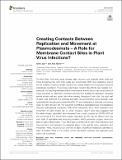Files in this item
Creating contacts between replication and movement at plasmodesmata – a role for membrane contact sites in plant virus infections?
Item metadata
| dc.contributor.author | Levy, Amit | |
| dc.contributor.author | Tilsner, Jens | |
| dc.date.accessioned | 2020-07-13T14:30:01Z | |
| dc.date.available | 2020-07-13T14:30:01Z | |
| dc.date.issued | 2020-07-03 | |
| dc.identifier | 268443852 | |
| dc.identifier | a2fcaceb-89df-4bf3-a4c5-11d5bec16712 | |
| dc.identifier | 000553960400001 | |
| dc.identifier | 85088507439 | |
| dc.identifier.citation | Levy , A & Tilsner , J 2020 , ' Creating contacts between replication and movement at plasmodesmata – a role for membrane contact sites in plant virus infections? ' , Frontiers in Plant Science , vol. 11 , 862 . https://doi.org/10.3389/fpls.2020.00862 | en |
| dc.identifier.issn | 1664-462X | |
| dc.identifier.uri | https://hdl.handle.net/10023/20237 | |
| dc.description | Parts of this work were funded by the University of Florida, Institute of Food and Agricultural Sciences, Early Career Seed Grant No. 00127818 to AL and by the UK Biotechnology and Biomedical Sciences Research Council (BBSRC) grant BB/M007200/1 to JT. | en |
| dc.description.abstract | To infect their hosts and cause disease, plant viruses must replicate within cells and move throughout the plant both locally and systemically. RNA virus replication occurs on the surface of various cellular membranes, whose shape and composition become extensively modified in the process. Membrane contact sites (MCS) can mediate non-vesicular lipid-shuttling between different membranes and viruses co-opt components of these structures to make their membrane environment suitable for replication. Whereas animal viruses exit and enter cells when moving throughout their host, the rigid wall of plant cells obstructs this pathway and plant viruses therefore move between cells symplastically through plasmodesmata (PD). PD are membranous channels connecting nearly all plant cells and are now viewed to constitute a specialized type of endoplasmic reticulum (ER)-plasma membrane (PM) MCS themselves. Thus, both replication and movement of plant viruses rely on MCS. However, recent work also suggests that for some viruses, replication and movement are closely coupled at ER-PM MCS at the entrances of PD. Movement-coupled replication at PD may be distinct from the main bulk of replication and virus accumulation, which produces progeny virions for plant-to-plant transmission. Thus, MCS play a central role in plant virus infections, and may provide a link between two essential steps in the viral life cycle, replication and movement. Here, we provide an overview of plant virus-MCS interactions identified to date, and place these in the context of the connection between viral replication and cell-to-cell movement. | |
| dc.format.extent | 8 | |
| dc.format.extent | 701819 | |
| dc.language.iso | eng | |
| dc.relation.ispartof | Frontiers in Plant Science | en |
| dc.subject | Plant virus | en |
| dc.subject | Membrane contact site | en |
| dc.subject | Replication | en |
| dc.subject | Cell-to-cell movement | en |
| dc.subject | Synaptotagmin | en |
| dc.subject | Plasmodesmata | en |
| dc.subject | QH301 Biology | en |
| dc.subject | SB Plant culture | en |
| dc.subject.lcc | QH301 | en |
| dc.subject.lcc | SB | en |
| dc.title | Creating contacts between replication and movement at plasmodesmata – a role for membrane contact sites in plant virus infections? | en |
| dc.type | Journal item | en |
| dc.contributor.sponsor | BBSRC | en |
| dc.contributor.institution | University of St Andrews. Centre for Biophotonics | en |
| dc.contributor.institution | University of St Andrews. Biomedical Sciences Research Complex | en |
| dc.contributor.institution | University of St Andrews. School of Biology | en |
| dc.identifier.doi | https://doi.org/10.3389/fpls.2020.00862 | |
| dc.description.status | Peer reviewed | en |
| dc.identifier.grantnumber | BB.M007200/1 | en |
This item appears in the following Collection(s)
Items in the St Andrews Research Repository are protected by copyright, with all rights reserved, unless otherwise indicated.

